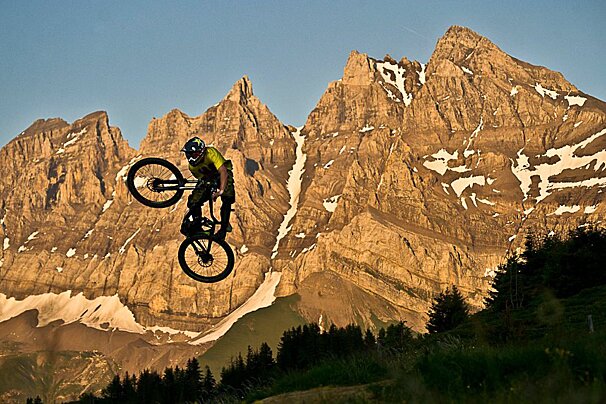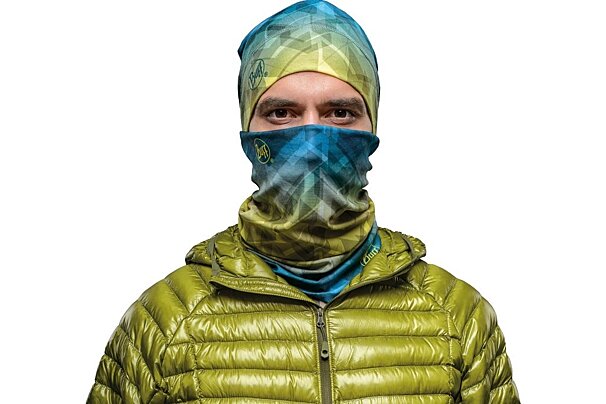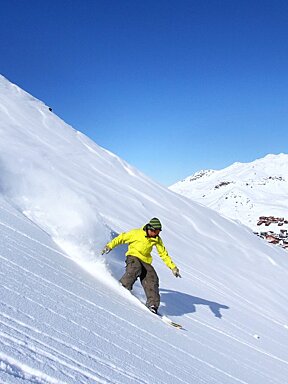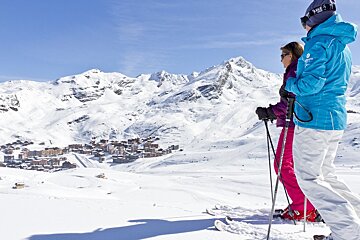
© Val Thorens OT
Ski area in Val Thorens
Discover the best of the Val Thorens ski area
The high-altitude resort of Val Thorens offers a wide variety of ski runs for all ages and abilities, from complete beginners to freeride experts, and is a part of the largest linked ski area in the world, the Three Valleys - all of which can be accessed with the same pass.
The main things to know about the Val Thorens ski area are:
The highest altitude resort in Europe
With 90% of the area above 2,000m, its own glacier and a peak elevation of 3,200m, amazing conditions are guaranteed throughout winter into late spring.
Longest winter in the Alps
Val Thorens is open from mid-November until early May (snow conditions dependent), that's nearly six months of skiing.
Great for families and beginners
A 'Famille Plus' resort with dedicated facilities for those with young children or elderly relatives, and exclusive zones for beginners only.
Part of the largest interlinked ski area in the world
As a part of the Three Valleys there are virtually no limits to where you can go with an all encompassing lift pass that includes Courchevel and Méribel.
Watch this

Val Thorens ski area
Situated in the Tarentaise Valley, within the Savoie department of the Auvergne-Rhone-Alpes region, Val Thorens is part of the Three Valleys and one of the ski resorts that makes up La Vallée de Belleville which also includes Les Menuires and Saint Martin de Belleville.
Val Thorens and Les Menuires combined have in the region of 66 lifts, giving access to 300km of pistes. The pistes are made up of 14% green, 27% blue, 38% red and 11% black runs (see the piste maps).
What's it like to ski and snowboard in Val Thorens?
Created about 45 years ago when property developer and contractor, Pierre Schnebelen, set about building the highest-altitude resort in Europe. However, it wasn't until the eighties that the largest cable car in the world (at the time), the Cime Caron, was built and Val Thorens positioned itself as a leading winter sports resort, which it remains to this day. The Val Thorens valley is made up of three separate villages, Les Menuires (1,850m), Val Thorens (2,300m) and Saint Martin De Belleville (1,450m). With its own glacier and a peak elevation of 3,200m, one thing you’re guaranteed is amazing snow conditions throughout the season and into late spring.
The slopes cover a massive area, ranging from a height of 3,230m to 1,450m, and a whopping 90% of Val Thorens’ runs are above 2,000m, meaning great snow conditions are pretty much guaranteed throughout the season making it one of the most popular ski resorts in Europe. The lift infrastructure here is first class, able to deal with high winds and high numbers of skiers, and the continued investment only serves to keep those lift queues to a minimum.
With several beginner areas, some more advanced skiing on the glacier and a great snowpark, this is a resort that suits all ages and abilities. For piste-lovers, the ski run Jerusalem is regularly rated in the world's top ten runs; recently remodelled and downgraded from a red to a blue, it is a long wide run that heads down to St Martin de Belleville.
Due to its height, the Val Thorens valley receives huge snowfalls and there are acres of fresh powder to be enjoyed. As and when the snow is falling there's still fun to be had.
Another favourite spot to head to first thing is the Pointe de La Masse. The area gets the best of the morning sun and there are a number of long runs down from its summit. This part of resort also features a number of steep slopes and three challenging blacks, Lac Noir, Dame Blanche and Rocher Noir. However, if you are just looking to cruise along in the sunshine, there are some long windy blues from the top of either Masse 1 or Rocher Noir lifts.
The areas on the east side of the valley, which have lifts granting access to Méribel, are best avoided first thing in the morning and between 15:00 and 16:00. During this time both those lifts and slopes will be jam-packed with skiers and boarders traversing between the Three Valleys. It's best to hit these pistes between 11:00 and 15:00. Favourite runs on this side are the previously mentioned Jerusalem, Plein Sud, a blue that leads into the heart of Val Thorens, and Petits Creux which takes you into Les Menuires.
Towards the end of the day take the Funitel Peclet gondola up to the glacier to take advantage of the last of the sun’s rays. The top of the gondola is another spot where you will see fantastic views of the whole valley and snow covered mountains stretching out into the distance. From here the Lac Blanc and Les Vires pistes are extremely wide allowing you to easily avoid other skiers and pick up some speed.
For freestyle boarders and skiers the snow-park in the Plateau sector of Val Thorens is probably the best spot in the Three Valleys to practise your tricks. It has a series of different size kickers, tables, rails and boxes suitable for all levels from beginner to the expert.
The potential off-piste terrain throughout Val Thorens and neighbouring Orelle is vast. The off-piste from the top of the Boismint lift has a technical entry into tasty chutes and bowls. Elsewhere the border with Méribel offers some great terrain and the glaciers are always worth exploring when conditions permit.
Over in Orelle, the fourth valley, the Glacier de la Pointe Renod is the summit of the Three Valleys and boasts spectacular views from the top of the Bouchet lift. This area also tends to be a peaceful spot as it's situated in a remote part of resort, away from the majority of the traffic and the surrounding runs require a certain amount of skill. The bottom of the glacier is where you'll find the famous Combe de Rosael black run, often a good place to aim for first thing in the morning for some fresh snow.

The Three Valleys ski area
There's load of skiing to be done in Val Thorens and once you've finished there, there's a whole load more skiing to be done across the Three Valleys.
It consists of eight resorts - Courchevel, La Tania, Meribel, Brides-les-Bains, Les Menuires, Val Thorens, Orelle and St Martin de Belleville (see the piste maps); with a massive 319 pistes totalling 600km in length, 200 lifts and 1,500 snow cannons it's a snow lovers paradise. Each individual valley is different and it's possible to find something for everyone.
There are 51 green pistes, 132 blues, 106 reds and 32 black pistes, with 11 links to the neighbouring resorts and 169 ski lifts. Beginner slopes, runs featuring in the world's top ten, huge powder bowls, tree skiing, glaciers and pro snow parks, all of which is connected by one of the fastest, modern lift systems around.
Méribel
Méribel has around 45 ski lifts giving access to terrain ranging from 1,100m to 2,952m in altitude, made up of eight green pistes, 25 blue, 24 red and seven black runs, plus one of the best snowparks in Europe complete with a beginner's jump line, a superpipe, and everything in between. The ski area is varied, so head to the Tougnète side in the morning and enjoy a sunshine ski, then head over to Saulire in the afternoon.
Beginners are highly unlikely to leave Val Thorens to head to Méribel, but for advanced skiers and intermediates up for a challenge it's worth the trip.
Advanced:
- Head up the Legends and Olympic chairlifts which will take you to 'Face'; the women's Olympic downhill run in 1992. Nicest mid-morning, when the snow is firm but softening slightly.
- If you take the Loze chair you can tackle the mogully Tetras run back down or take Pas du Lac up from Méribel Mottaret and the slightly less challenging (but still advanced) Sanglier or Grande Rosiere pistes back to resort. Both the red runs at the top of the Mont Vallon lift are long, steep and often full of moguls.
- Look for the 'Bumps' run next to Martre piste ending at the plateau in the centre of Mottaret.
- Finally, the steep couloir under the Saulire Express lift has been turned into a black run, previously name Couloir Tournier, it is now named the GoPro Couloir. This couloir is narrow and steep, (37° pitch) with no escape routes, and is recommended for experts only.
Off-piste:
- From Loze Express to Dent du Burgin - about halfway along the Boulevard de la Loze track drop off to the right for large, swooping open plains of fresh tracks and powder. Under no circumstances should you take the track that leads over to the Dent du Burgin chair if it is closed - avalanche risk is high here.
- Underneath the Loze Express chair there is a very popular off-piste run that gets tracked out very quickly, so head there first. Cut off to the right in between the trees where it's possible to enjoy powder all the way down to Méribel Village on a good day.
- The area around the Côte Brune chair is beautiful in fresh powder, where a short hike delivers some incredible descents and fresh tracks. Stop at the Ski Patrollers’ hut at the top of the lift to check with them the safe routes – they are always happy to advise.
- Cut immediately right as soon as you come off the Olympic Express chair, hike along the ridge (this will be hell for snowboarders - sorry) until you are satisfied that the slopes down to the right are suitably untouched. For the more daring, the further along you hike, the bigger the drop in is. Be careful not to end up in the stream at the bottom - once you reach it, stop and find an easy crossing point, then enjoy the winding Villages piste all the way down to Les Allues.
- Take the Roc de Tougne (Méribel's toughest drag lift, especially on a powder day) and it will immediately become apparent where you should be skiing. Long off-piste runs stretch out on either side of the drag track and a bit of a traverse at the top will be sure you find you some untouched fluff.
Courchevel
Situated on the northern side of the Three Valleys ski area, it is connected to Val Thorens via Méribel and a large number of lifts, so there are a number of routes, making it especially easy to head over there for the day. And it's definitely worth it, just don't miss those last lifts back over to Val Thorens, a taxi from Méribel isn't cheap. Made up of five villages that sit below the pistes, on a clear day you will get stunning views of Mont Blanc. It is split into three main ski areas: La Tania, Courchevel (1850) and Courchevel Moriond, with 150km of piste skiing and over 600 snow cannons helping to keep it snow sure all season.
As with Méribel, beginners aren't going to ski to Courchevel from Val Thorens, this really is a trip for advanced skiers who can get up the speed to get there and back in a day. Just don't forget those return lift closing times - it's not cheap to get a taxi back to Val Thorens.
Advanced:
- Known for having some of the world's hardest and most challenging black runs, plus the couloir runs that everyone talks about; the area to head to would be Saulire for some of the best snow possible and access to those couloirs. Two of the couloirs are recognised pistes; Grand Couloir and the GoPro Couloir, which is technically in Méribel. The other pistes around here are steep and challenging and often furnished with moguls.
- Chapelets is a red run over the far side of the resort and is a favourite spot amongst many, starting off steep before gently mellowing out, it's great to hit this first thing when it's been freshly groomed. The tree runs around here are where to head in a white-out.
- The La Tania ski area has a great variety of runs, the black Dou des Lanches is worth a mention, and the face of the Rocher de la Loze known locally as the Freeride Face, is only for the most experienced skiers.
Off-piste:
- Highlights include the Les Avals valley with over 1,000m of powder, the Saulire couloirs and the Roc Merlet face which will test the most advanced of you.
- Underneath the Dou des Lanches lift, there is easily accessible powder, cliffs, steeps and trees which makes for some awesome and varied terrain.
- The Bel Aire area above Courchevel Moriond is safe and easy to access off either side of the Pyramide, Signal and Chapelets.
Snowparks:
- The Family Park is located alongside the Verdons piste just above the village at 1850 and has something for all levels of freerider, with gentle, small features ideal for those looking to progress their freestyle skills.

Orelle - the fourth valley
The Three Valleys is actually made up of four valleys...confusing we know. Located on the far side of Val Thorens, Orelle boasts the ski area's highest point: a massive 3,230m. It became a part of the Val Thorens ski area in 1996, when the Three Vallées Express gondola defied evolution and technology by linking the two resorts through forests and over steep climbs. At 5km long and over 1,470m in altitude it feeds skiers into Orelle from Val Thorens and beyond.
Conditions here are usually excellent and the stunning views are well worth the 15-minute cable car ride over from Val Thorens. The slopes here are a dream for skiers and snowboarders of any level.
The two latest gondolas, Orelle and Orelle-Caron travel at 7m/second making them the fastest in France and amongst the fastest in the world.
- Orelle will replace the Three Vallées Express gondola to offer greater speed, safety and comfort, with a higher capacity.
- Orelle-Caron will climb from Plan Bouchet in Orelle to Cime Caron in only seven minutes - it's 2,235m in length over 820m elevation gain and is fully glazed for breathtaking views.
Orelle has 11 green pistes, 33 blues, 29 reds and nine black slopes all between 900m and 3,200m. It also has the highest run in the whole Three Valleys, the red run Coraia which starts at 3,230m and offers one of the best views in the Alps plus a long and relatively easy descent into this pretty, tucked-away valley.
If looking for some off-piste, the slopes around the Bouchet lift are the best place for freshies.

When is the ski area open in Val Thorens?
The winter season in most ski resorts usually runs from mid-December to mid-April, but with this high-altitude resort we're looking at mid-November to mid-May with any early lift openings depending on snow conditions (check Ski Lift Opening Dates for this winter's schedule). Your holiday will be very much determined by the weather and snow conditions, and therefore the time of year you choose to visit is important. If it's sunny pistes and a cold glass of wine on a mountain restaurant terrace, come in March or April. If your perfect ski break is about quiet slopes and lots of fresh snow, then January is the time to come. Or if you want numerous activities organised for your children during their school holidays, February is for you.
Whenever you choose to come, as long as the lifts are open, the local pisteurs will make the best of the snow (real and/or artificial), and groom the pistes to perfection so that you get the best possible conditions.

Beginner areas in Val Thorens
Val Thorens is, for beginners, quite simply one of the best places to learn and improve. In Val Thorens alone there are 11 green runs and 29 blues. If you extend that to the whole of the Belleville Valley, learners have access to 20 green runs and 60 blues. The best thing about this resort is that unlike the majority of others, it has gentle pistes that connect the various different areas of the valley, completely opening up the ski domaine for those who are still building up their confidence. It means that learners get as much variety as advanced skiers and spend less time, if any, doing the same slopes over and over again.
The valley has over five designated beginner zones. In Val Thorens this covers the area between the Roc, Cascades and 2 Lac lifts (it is worth noting that the four magic carpet lifts are free of charge). For those based in Les Menuires, this zone spans the space below and to the sides of the Doron lift.
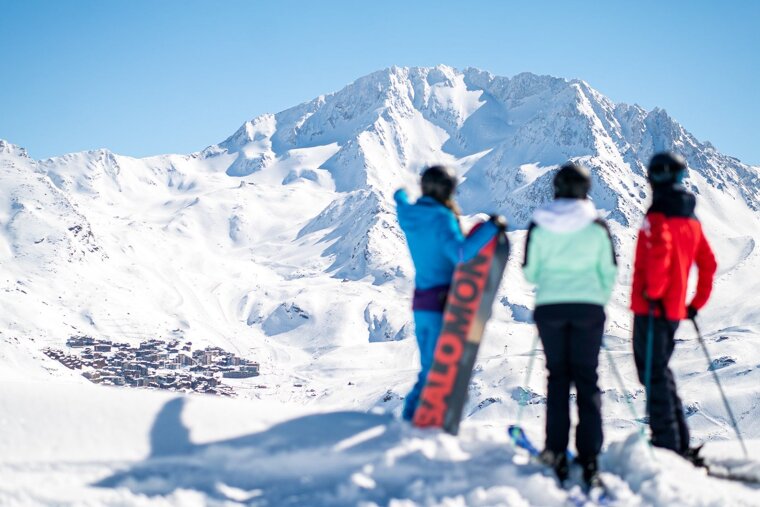
Advanced areas in Val Thorens
Val Thorens has a wide variety of steep ski runs for those that like a bit of a challenge. With access to three different glaciers and four different summits, skiers and boarders are spoilt for choice.
Jerusalem's start point is tucked away, which is why this blue run that was a red run is always quiet, and usually keeps excellent snow. We mention it here because this perfect intermediate run is rolling with gentle and steep sections, and the off-piste to either side is safe and gentle – ideal for first forays into powder.
All three runs from the top of the Cime Caron lift are excellent. The famous Combe de Rosael is often filled with huge moguls that will test your skills and takes you to the gorgeous ‘fourth valley’. It’s seriously steep, so don’t attempt it if it's icy. Black run Combe de Caron and red Col de l’Audzin both run back towards Val Thorens.
Being the furthest point, the slopes around the Bouchet lift in the fourth valley of Orelle, are the best place to get fresh powder. The runs up here are wide and often quiet, allowing you to pick up as much speed as you can handle.
The Point de La Masse has four tricky blacks: Masse, Lac Noir, Dame Blanche and Rocher Noir. It is the perfect spot first thing in the morning as it avoids the Three Valleys traffic and gets the best of the pre-lunch sunshine.
Another good place, although slightly busier as the gondola leaves from the centre of resort, are the runs at the top of the Funitel Peclet. Christine is the steepest and longest of these runs and gives you the chance to follow up with the col red run at the top of the Glacier de Thorens accessed via the Moraine lift.
Allamande is a winding red run from the top of Three Marches down towards the resort of Les Menuires, and has enough twists, turns, long shusses and steep bits to keep everyone happy.

Snowparks in Val Thorens
Val Thorens has a fantastic 70,000m² snowpark on the Plateaux Pistes. You can access it from the Moutière chairlift, and the Plateaux drag lift allows you to slide back up to the top once you've jumped and somersaulted (hopefully on purpose) your way through the course!
Like most slopes in Val Thorens it can be a little hard in the mornings so it's best to wait until the afternoon sun has warmed and softened the snow. This park does have some proper kickers and for years it was Val Thorens who had the biggest park in the Three Valleys. You can still find some fairly meaty wedges here and thanks to the parks high position they stay in good shape until late in the season.
All the runs are colour coded depending on their difficulty: green (easy), blue (medium), red (difficult) and black (very difficult). The snowpark has five zones; a boardercross (800m long), three freestyle zones which are classified according to their technical difficulty (beginners, intermediates and experts) and a Jump'Air (a jump with arrival on a "stunt man's" mattress, airbag). The snowpark contains Whoops (a succession of waves), a corner (raised bend), a jump table and big air, a wall ride (extended snow wall), a hand rail and a half pipe.
The park in Val Thorens is also one of the 'freestylepark' locations so you can film yourself on the kickers here and try out the airbag.

Off-piste areas in Val Thorens
Val Thorens is one of the most stunning areas in Europe for off-piste skiing and ski touring. The area is surrounded by six glaciers, giving endless fields of powder snow in breath-taking surroundings. Discover the glaciers of the Vanoise (check out the descent from the Gebroulaz glacier towards Méribel or Pralognan) and the most beautiful off-piste skiing in the Three Vallées on the amazing Maurienne side.
If you are an experienced off-piste skier Val Thorens has several recognised off-piste tracks starting at the top of several of the peaks. The weather must be taken into account when attempting any of these off-piste itineraries, not just on the day but also the build-up to it as, due to the altitude of Val Thorens, the snow and wind can create some precarious situations.
Popular off-piste routes include: The Pierre Lory from the top of the Col chair into the Maurienne Valley; Lac du Lou from the Combe de Rosael black run from La Masse; La Masse down Vallée des Encombres; further down the valley above St Martin the area between Jerusalem and Pramint is renowned for its off-piste skiing, especially with the instructors and their clients. But you have to be quick, otherwise the Meribellians get there first!
Always make sure you are prepared before embarking on any off-piste skiing or snowboarding. Check out our Avalanche Safety guide. It's always advisable to hire an off-piste guide who will have extensive knowledge of the area and the mountains.
Bad Weather areas in Val Thorens
There are certain runs that offer more contrast, providing vast amounts of skiing/snowboarding when the flakes are falling. The trick is to head for the pistes that are tree-lined; the trees help provide definition when everything else seems to be white.
If you are up the mountain and the visibility closes in then why not try heading to the lower pistes near resort as these may be below the cloud and you might be able to catch a few good runs. Try the pistes that come off the top of the Cascades chairlift such as the gentle blue Dalles or harder black Cascades piste. Head up the Plein Sud and take the gentle blue piste down to the bottom of the Cairn bubble.
Alternatively, if the cloud is sitting in the valley it's worth bearing in mind that it might be clear high up the mountain, just make sure you head up a bubble or cable car as if the weather is still bad high up you will probably want an easy route down. Check out our webcams and see what the weather is like up the beautiful Val Thorens mountains. Also if it is snowing in resort then it will usually mean it is snowing up top, making for great skiing and quiet pistes!
More inspiration...
Take a look at this year's Ski Pass Prices or, if you're not sure which pass to buy.
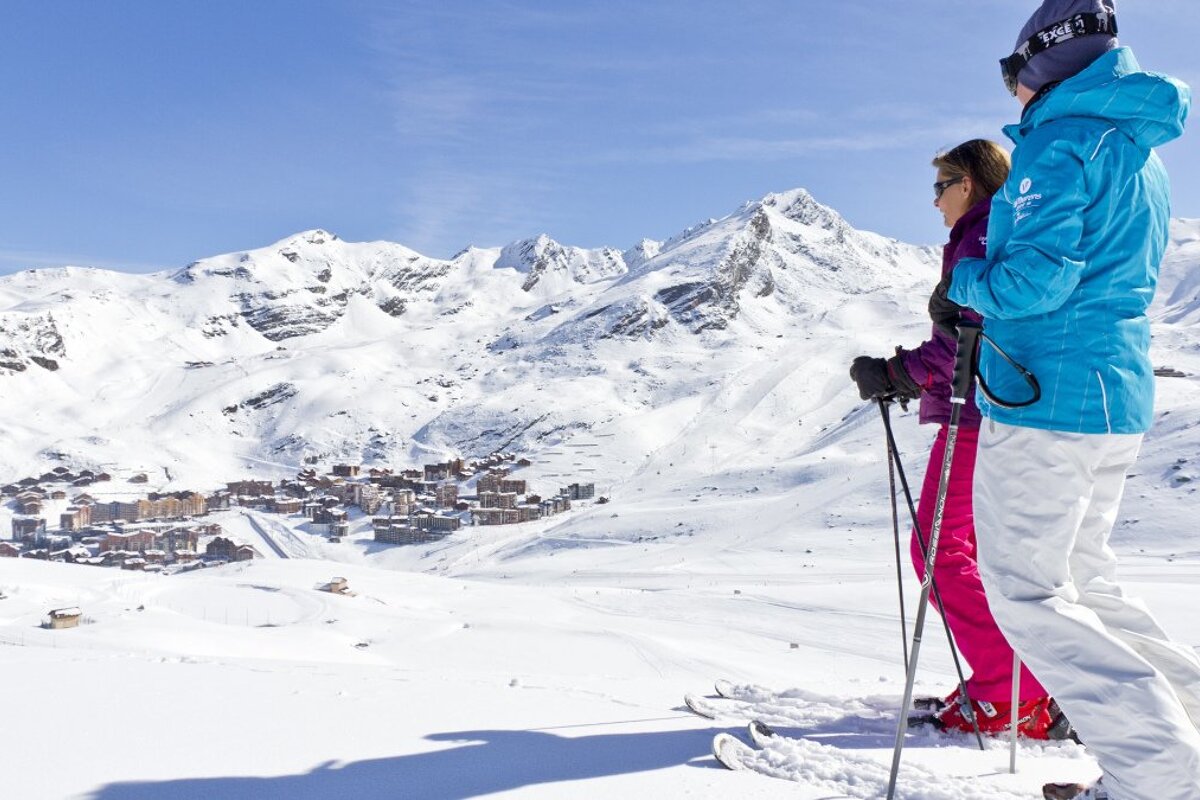




![[itemref] living-room](https://cdm0lfbn.cloudimg.io/v7/_images_base_/image_uploader/arkiane/original/inter_00210069.jpg?ua=1579868382&p=carousel)











